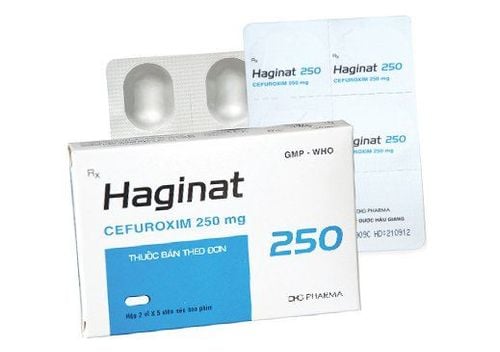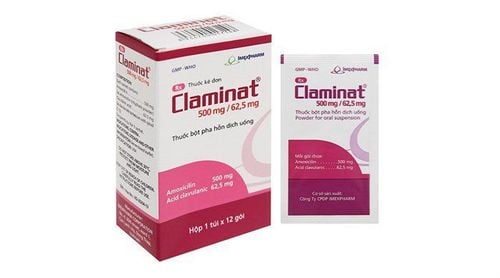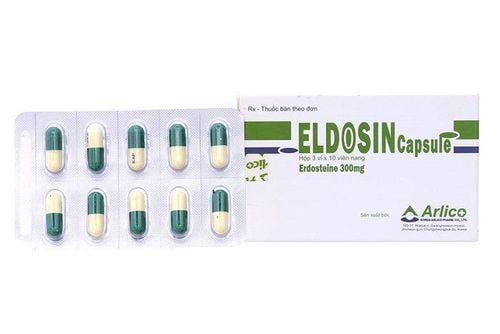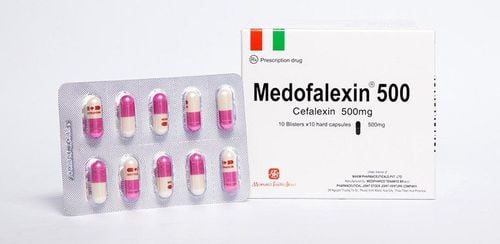This is an automatically translated article.
Cefuroxim 500mg belongs to the group of cephalosporin antibiotics, is indicated in cases of bacterial infections such as urinary tract infections, respiratory tract infections, gastrointestinal infections... Cefuroxim 500mg is a prescription drug, patients do not arbitrarily use it. used without a doctor's prescription.
1. What disease does Cefuroxim 500mg treat?
1.1. Indications for use of the drug Cefuroxim 500mg Cefuroxim medicine 500mg contains the active ingredient cefuroxime axetil (equivalent to 500mg cefuroxime) and excipients including colloidal silicon dioxide, crystalline cellulose, sodium lauryl sulfate, hypromellose, magnesium stearate, propylene glycol, talc... The drug belongs to the group of antibiotics Cephalosporin, indicated for the treatment of infections caused by susceptible bacteria in the following cases:
Sensitive bacteria causing lower respiratory tract infections (acute bronchitis, inflammation of the respiratory tract). lung, chronic bronchitis); upper respiratory tract infections (sinusitis, otitis media, pharyngitis, tonsillitis); urinary tract infections - genitourinary (cystitis, pyelonephritis, urethritis); Skin and soft tissue infections (impetigo, pustules); treatment of Lyme disease in the early stages with symptoms such as erythema multiforme caused by Borrelia burgdorferi. 1.2. Pharmacodynamics Cefuroxime is an antibiotic with broad antibacterial activity, the antibacterial mechanism of which has been shown to inhibit bacterial cell wall synthesis by binding to target proteins (penicillin-binding proteins). Therefore, in many cases the cause of bacterial resistance is the secretion of cephalosporinase enzymes or the modification of penicillin-binding proteins. In particular, the most specific and effective antibacterial activity of Cefuroxime is on common pathogens, including beta-lactamase/cephalosporinase-producing bacteria strains of gram-negative and positive bacteria.
Cefuroxime is stable to many beta-lactamase enzymes of gram-negative bacteria. The antibacterial activity includes both aerobic and anaerobic gram-negative and gram-positive cocci, penicillinase-producing Staphylococcus strains. The antibiotic Cefuroxime has a low minimum inhibitory concentration (MIC) against Streptococcus strains (groups A, B, C and G); strains of Meningococcus and Gonococcus. However, along with the overuse of antibiotics, the rate of resistance and MIC concentrations for these strains have also changed. Specifically, bacterial strains Bacteroides fragilis, Enterobacter, Proteus indol positive have decreased sensitivity to cefuroxime. Campylobacter spp, Clostridium difficile, Pseudomonas spp, Legionella spp and Acinetobacter calcoaceticus are all insensitive to Cefuroxime. Recent studies on drug resistance in Vietnam show that Haemophilus influenzae strains isolated from healthy children have high rates of resistance to Cefuroxime. This is a bad sign that it is necessary to limit the use of broad-spectrum antibiotics, only in patients with severe infections.

Thuốc Cefuroxim 500mg được sử dụng trong điều trị một số bệnh lý nhiễm trùng
1.3. Pharmacokinetics Cefuroxim axetil is rapidly absorbed from the gastrointestinal tract after oral administration, followed by hydrolysis in the intestinal mucosa and blood, releasing cefuroxime into the systemic circulation.
Cefuroxime is best absorbed when taken with meals. Peak plasma concentrations vary depending on whether the drug is a suspension or an oral tablet. In particular, the peak plasma concentration when using the suspension form reached 75% when using the oral tablet form. About 50% of the drug administered in the systemic circulation is bound to plasma proteins, the half-life (t1/2) is about 70 minutes and tends to be longer in patients with renal failure and neonates.
The drug is widely distributed throughout the body tissues, including sputum, pleural fluid, synovial fluid, bone and aqueous humor. In which the apparent volume of distribution (Vd) in healthy adults ranges from 9.3 to 15.8 l/1.73 m2. The drug can cross the blood-brain barrier in cases of meningitis, cross the placenta and be excreted in low concentrations in breast milk.
Cefuroxime is not metabolized and is eliminated unchanged, in which about 50% of the drug is excreted in the renal tubules and 50% is excreted by glomerular filtration. In addition, a small amount of the drug is excreted in the bile. Cefuroxime reaches high concentrations in the urine.
2. Dosage of Cefuroxime 500mg
2.1. Dosage of Cefuroxim 500mg The dose of Cefuroxim 500mg depends on the patient as well as the medical condition and should be taken with meals. Note that Cefuroxime 500mg should be used in the course of 5-10 days, usually 7 days. Specifically as follows:
- For adults:
Acute or chronic bronchitis, secondary bacterial infections, uncomplicated skin and soft tissue infections: Take 250-500mg of cefuroxime, repeat after 12 hours; Maxillary sinusitis, pharyngitis, tonsillitis: Take 250 - 500mg of cefuroxime, repeat the dose after 12 hours; Uncomplicated urethritis, cervical gonorrhea, uncomplicated rectal disease in women: Use a single dose of 1g cefuroxime; Newly acquired Lyme disease: Take 500mg of cefuroxime twice a day. - For children:
Tonsillitis, pharyngitis: Take 250mg/day; Impetigo, otitis media: Take 250mg/time of Cefuroxime, use 2 times a day or as directed by a doctor; 2.2. Treatment of drug overdose Besides answering questions related to the question "What disease does cefuroxime 500mg treat?" The treatment of overdose should also be considered. Accordingly, most patients who overdose on the drug will experience symptoms of nausea, diarrhea, and vomiting. In rare cases, nerve irritation leads to seizures, especially in people with kidney failure. The following is how to deal with an overdose of Cefuroxime 500mg:
Protect the patient's respiratory system by means of ventilation before administering fluids. In case of convulsions, the drug should be stopped immediately and treated with anticonvulsant measures; Remove drugs from the blood by means of hemodialysis, peritoneal dialysis.

Người bệnh nên sử dụng thuốc Cefuroxim 500mg theo hướng dẫn
3. Side effects
Some side effects may be encountered when taking cefuroxime 500mg as follows:
Sudden high fever, chills, joint pain, itchy rash and swollen glands; Occurrence of symptoms such as seizures, chest pain, heart palpitations, blood in the urine or stools, diarrhea...; rash, jaundice, pale skin, bruising, peeling; urinating less, excessive thirst, loss of appetite, sudden weight gain, muscle swelling, shortness of breath, or numbness; Less severe symptoms such as headache, nausea, vaginal itching, nasal congestion.
4. Note when taking medicine
4.1. Contraindications and cautions Some subjects need to be cautious and contraindicated when using cefuroxime 500mg antibiotics as follows:
People with kidney disease: The drug elimination process mainly occurs in the kidneys, so cefuroxime should be used. in patients with kidney disease increases the burden and decreases renal function. Therefore, patients need to inform the treating doctor when suffering from diseases such as kidney stones, kidney failure, glomerulonephritis... so that they can replace the drug safely or adjust the appropriate dosage; Elderly people: Using Cefuroxime in the elderly can easily affect kidney function, reduce the drug elimination process, so there are many side effects. 4.2. The effect of the drug on special subjects Can Cefuroxim 500mg be used for pregnant women and lactating women? Accordingly, the effects of Cefuroxim on specific subjects are as follows:
Pregnant women: There are no studies to determine the risks of the drug to the fetus. However, pregnant women do not arbitrarily use the drug without a doctor's prescription; Women who are breast-feeding: The drug passes through the milk ducts, so it may cause unwanted effects on the baby; Driving and using machines: Cefuroxime has no influence on the ability to drive or use machines.
5. Drug interactions
Cefuroxim 500mg drug can interact with some drugs when used together as follows:
- Interaction reduces effect: Sodium bicarbonate and ranitidine reduce the effect of cefuroxime axetil. Therefore, take cefuroxime at least 2 hours apart from these drugs.
- Increased effect: High doses of probenecid reduce renal clearance of cefuroxime, resulting in higher and longer plasma concentrations of cefuroxime.
- Increased toxicity: Concomitant use of cefuroxime and aminoglycosides increases the risk of nephrotoxicity.
In summary, Cefuroxim 500mg belongs to the group of Cephalosporin antibiotics, indicated for use in the treatment of infections caused by susceptible bacteria. For safe and effective use, patients should consult a doctor and use the drug as prescribed.













